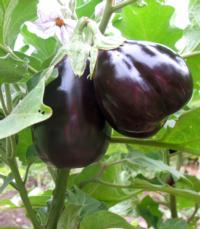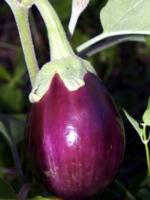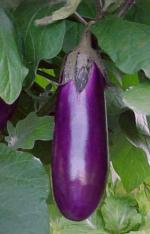Eggplant, growing
-
Planting

Plant and handle eggplant in the same general way as tomatoes, although eggplant is more sensitive to cold than tomatoes. Warm to hot weather throughout the season is necessary for good production.Eggplants are generally not planted from seed but grown from transplants because of their long growing season requirements.
Use young plants about 3 weeks old with 4 to 6 true leaves. The plants should be wider than tall, stocky, succulent, and slightly hardened to outdoor conditions. Hardening off means to gradually introduce young plants to a change in environment (more sun, cooler temperatures, etc.).
The site should be in full sun. Use a rich, well-draining soil, amended with organic matter such as compost plus a fertilizer high in phosphorous.Plant each eggplant deeply enough to bury the stem as far as the first leaf. Place plants about 18 to 24 inches apart. Press the soil firmly around the plant and water thoroughly to remove any air pockets. If transplanting in the summer, shade the plants in the middle of the day for the first week.
Watering
Proper watering is very important. Drip irrigation or furrow irrigation on raised beds, instead of using sprinklers, will keep your soils well drained and protect against diseases such as root rot. Keep the root zone moist throughout the growing season.
Eggplants roots reach about 2 feet deep and plants should not be subjected to water stress. Stress during the bloom can cause substantial reduction in fruit set. Keep adequate moisture in the deeper soil layers even when plants are small. Deep moisture is harder to replace later in the growing season without overirrigating.
When to plant
Eggplant requires warm temperatures for optimum growth and fruit development. A long growing season of 70 to 120 days, depending upon the variety, is required for transplanted crops.
The ideal daytime temperatures should be in the range 80° to 90° F and night time temperatures should not go below 60° to 65° F. Eggplant does not tolerate frost, and growth will be significantly retarded if night temperatures are below 60° F. Once plants reach the flowering stage, low temperatures and low-intensity light will cause pollen to be nonviable and fruit will likely not set.
Read more about when to plant eggplant.
VarietiesThe standard eggplant produces egg-shaped, glossy, purple-black fruit 7 to 10 inches long when fully mature. Only a few plants are needed to meet the average family's needs.
White, ornamental varieties are available and edible but are of poor eating quality.The long, slender Japanese eggplant has a thinner skin and more delicate flavor.
Both standard and miniature eggplants can be grown successfully in containers, but standard varieties yield a better crop.
Read more about eggplant varieties.



